各国家肢体语言的意思
- 格式:doc
- 大小:28.50 KB
- 文档页数:4

日本人朝我竖小手指,到底几个意思?作为肢体语言的一种,手势语在我们日常生活中也是十分常用的。
两只手,十个手指,能组合出来的手势并不多,但是各个国家,各个民族对同样的手势,解释有时候确实是大相径庭。
有时候不说话,仅仅一个手势,友谊的小船就说翻就翻。
那么那些常用的手势在日本都是什么意思呢?与我们所理解的都是一样的吗?下面我们来看一下我们经常做的一些手势,是否有一些是有区别的。
竖大拇指手握拳竖起大拇指,绝大部分都是好的意思。
是做的好,好样的,很棒的意思。
大拇指在日语里叫做「親指(おやゆび)」因为里面包含了「親(おや)」,也就是双亲的意思,在日本,如果在路上碰见灵车,或者路过墓地,有说法是要把大拇指藏在拳头里,不要露出来,当然这只是一个流传的习俗。
OK手势用大拇指和食指做圆圈状的OK手势,在日本也依然是表示好的,可以的意思。
但是在其他的一些国家,就不尽然了。
比如说在法国、希腊和巴西,这个手势却是有侮辱性质的意思。
特别是在巴西,这里面还包含了一定程度的性方面的含义,所以在巴西对女性最好不要用这个手势觉得上面的都没啥区别?那么下面开始放个大招。
竖起小指首先在中国,竖起小指是一个不好的意思,用来贬低对方表达不值一提,无用、无能、废物的意思。
然而在日本,小指的意义却是完全不一样的。
日本人在做约定的时候,会用小指拉钩,曾经的游女会将小指切下送给自己的心上人,据说这便是拉钩在日本叫做「指切り」的原因。
在日本的黑帮,如果想要退出组织金盆洗手,也有要将小指切下的说法。
据说小指连接着一个距离心脏很近的穴位,所以小指就是内心的一个代表。
在日本如果你看到有AB两个男性谈话的时候A一脸八卦并伸出小指,而B一脸为难或者羞涩,那么值得注意的事情有两个:第一,A是个八卦台风眼,注意回避;第二,B小哥哥已经结婚或者有了女朋友了……在日本男性竖起小指,代表提及了“妻子”、“情人”或者”女朋友”等女性。
所以在日本,看见有人竖起小指,不要以为他们吵架了,也许只是在挖掘八卦哦!我们经常在日剧日漫里看到的所谓的「運命の赤い糸(うんめいのあかいいと)」(命运的红线),系着的也是双方的小指。
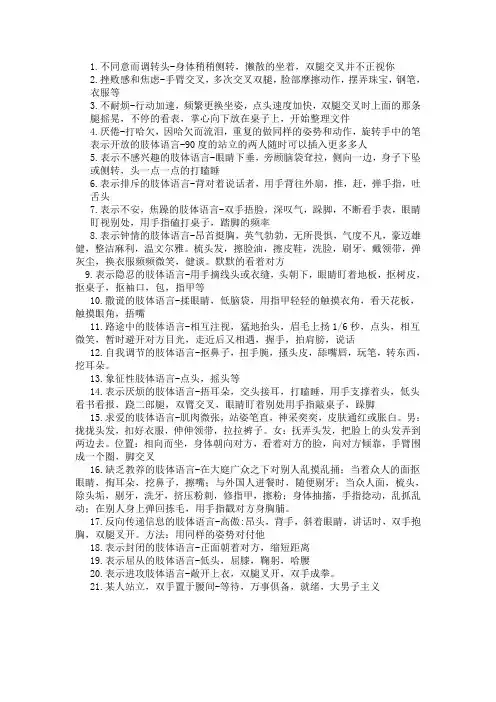
1.不同意而调转头-身体稍稍侧转,懒散的坐着,双腿交叉并不正视你2.挫败感和焦虑-手臂交叉,多次交叉双腿,脸部摩擦动作,摆弄珠宝,钢笔,衣服等3.不耐烦-行动加速,频繁更换坐姿,点头速度加快,双腿交叉时上面的那条腿摇晃,不停的看表,掌心向下放在桌子上,开始整理文件4.厌倦-打哈欠,因哈欠而流泪,重复的做同样的姿势和动作,旋转手中的笔表示开放的肢体语言-90度的站立的两人随时可以插入更多多人5.表示不感兴趣的肢体语言-眼睛下垂,旁顾脑袋耷拉,侧向一边,身子下坠或侧转,头一点一点的打瞌睡6.表示排斥的肢体语言-背对着说话者,用手背往外扇,推,赶,弹手指,吐舌头7.表示不安,焦躁的肢体语言-双手捂脸,深叹气,跺脚,不断看手表,眼睛盯视别处,用手指磕打桌子,踏脚的频率8.表示钟情的肢体语言-昂首挺胸,英气勃勃,无所畏惧,气度不凡,豪迈雄健,整洁麻利,温文尔雅。
梳头发,擦脸油,擦皮鞋,洗脸,刷牙,戴领带,弹灰尘,换衣服频频微笑,健谈。
默默的看着对方9.表示隐忍的肢体语言-用手摘线头或衣缝,头朝下,眼睛盯着地板,抠树皮,抠桌子,抠袖口,包,指甲等10.撒谎的肢体语言-揉眼睛,低脑袋,用指甲轻轻的触摸衣角,看天花板,触摸眼角,捂嘴11.路途中的肢体语言-相互注视,猛地抬头,眉毛上扬1/6秒,点头,相互微笑,暂时避开对方目光,走近后又相遇,握手,拍肩膀,说话12.自我调节的肢体语言-抠鼻子,扭手腕,搔头皮,舔嘴唇,玩笔,转东西,挖耳朵。
13.象征性肢体语言-点头,摇头等14.表示厌烦的肢体语言-捂耳朵,交头接耳,打瞌睡,用手支撑着头,低头看书看报,跷二郎腿,双臂交叉,眼睛盯着别处用手指敲桌子,跺脚15.求爱的肢体语言-肌肉微张,站姿笔直,神采奕奕,皮肤通红或胀白。
男:拢拢头发,扣好衣服,伸伸领带,拉拉裤子。
女:抚弄头发,把脸上的头发弄到两边去。
位置:相向而坐,身体朝向对方,看着对方的脸,向对方倾靠,手臂围成一个圈,脚交叉16.缺乏教养的肢体语言-在大庭广众之下对别人乱摸乱捅;当着众人的面抠眼睛,掏耳朵,挖鼻子,擦嘴;与外国人进餐时,随便剔牙;当众人面,梳头,除头垢,剔牙,洗牙,挤压粉刺,修指甲,擦粉;身体抽搐,手指捻动,乱抓乱动;在别人身上弹回拣毛,用手指戳对方身胸脯。

这些⼿势在世界各地意思完全不⼀样!导语:从前有个德国⼈在中国买煎饼果⼦,他想买两个,结果⽼板给了他⼋个,这是怎么回事呢?各国⼿势⽂化差异- 数字⼿势德语君刚来德国的时候,跟德国⼩伙伴聊着聊着天随⼿⽐划了个数字,结果他们竟然看不懂是⼏,然后我们发现原来彼此如何⽤⼿势表⽰数字都有巨⼤的差异。
这是我们中国的1-10⼿势。
不过德语君习惯把中指放在⾷指上⾯来表⽰10,可能也是地区差异吧= =这是德国(中欧和西欧的表⽰法)的1-10回到刚刚说的煎饼果⼦的梗,中国表⽰“8”的⼿势刚好跟德国表⽰“2”的⼿势相同,⼤家不要搞混了哟~世界上其他地区的数字表⽰⽅法也很有意思。
这是⽇本的数字⼿势,有两个版本,感觉被绕晕。
美国的数字⼿势好像是我们和欧洲的混合版(图/brainworker)除了数字的表达⽅式不同之外,还有很多我们平时习以为常的⼿势或者⾝体语⾔,在其他的国家和⽂化⾥有着不同的含义。
- 肯定和否定很多国家都⽤点头来表⽰肯定的意思,但是在印度、巴基斯坦和保加利亚却完全相反,他们⽤摇头表⽰肯定。
在埃塞俄⽐亚,⼈们把脖⼦往后缩来表⽰肯定的意思。
这种脖⼦往后缩的动作在阿拉伯国家、希腊和意⼤利南部⼜表⽰否定。
- 如何表⽰“我”德国⼈竖起⾷指,指着⾃⼰的胸⼝或者肚⼦来表⽰“我”;美国⼈则把右⼿平放在⼼脏上;⽇本⼈会⽤⾷指和中指指在⿐⼦上。
- 竖⼤拇指这个⼿势在我们看来是夸奖别⼈的意思,在德国是数字1或者很棒的意思,在澳⼤利亚和尼⽇利亚这个⼿势是⼀种粗俗的侮辱⼈的⽅式;在⼟⽿其则被认为是对同性恋⾏为的邀请;在拉美、俄罗斯、撒丁岛和希腊同样是⼀种骂⼈的⼿势。
- V字⼿势这个⼿势最⼴为⼈知的意思⼤概是胜利或者和平。
但是在英国、澳⼤利亚和马⽿他,如果⽐V字⽽且⽤⼿背对准别⼈的话,就是⼀种侮辱了,⽽且程度更甚于竖中指。
不过这个⼿势在东亚很受欢迎,⼤家拍照的时候都喜欢⽐划这个⼿势。
- OK⼿势我们所认为的OK⼿势就是表⽰事情办妥了,可以之类的意思,但是在希腊、俄罗斯和⼟⽿其这个⼿势代表的是⼈体的性器官,是程度⾮常严重的辱骂。

中国手势在其他国家会被误会的的例子
在美国和国内,大家看到「ok」这个手势都会很高兴。
因为它代表「好的」、「干得漂亮」、「没问题」等等这样积极的意思。
在日本,很像一枚硬币的样子,所以用它代表着钱。
在巴西、德国,这象征着人体上非常隐蔽的孔。
对他们而言,做这个手势与「竖中指」无异!
在法国,这个手势表示「零」或者「毫无价值」,所以比出这个手势就是说对方一文不值。
在希腊和土耳其,这个手势也相当低俗,相当于影射对方是同性恋者。
在撒丁岛和希腊地区也表示「滚开」,有喜欢用这个手势搭便车和寻求帮助的人在这些地方就千万不要用啦!因为几乎没有人会停下来。
02 ◆ 竖大拇指
在美国和欧洲部分地区,竖大拇指还通常用来表示搭车。
有朋友在国内骑自行车,遇到下暴雨时这么做过,而且真的有车子会停下来哦!
在尼日利亚,这手势被认为是侮辱性手势。
在澳大利亚则表示骂人,哪怕是在希腊和意大利,向上竖大拇指也意味着滚蛋等含义。
所以如果你在这些国家的餐厅吃饭,觉得食物好吃,一定不要鲁莽,要控制住你的大拇指啊!
如果你查看一下中国外交部的公民出国指南,就会发现有明确的说明「向伊朗人称好的时候不能竖大拇指」,伊朗人都非常忌讳这点
的。

美国是一个肢体语言国家,在美国生活中,我们该如何辩别什么是得体的示意动作?什么是粗鲁的示意动作,让自己避免尴尬呢?这里列举了20种美国人最常用的示意动作和身势语。
1、握手
美国:北美人在见面时握手相互致意,他们从儿童时代起就学会握手时要紧紧地有力握一下。
其他地区:虽然几乎全球都以握手为欢迎对方的方式,但日本人仍然喜欢向对方鞠躬致意(但不久将迎合西方人的习俗,也用握手致意)。
东南亚人是两掌在胸前对合作祈祷状。
中东人和许多东方人在握手时,往往轻轻握一下,那是因为在他们的文化里,紧紧握手意味着挑衅。
2、目光接触
美国:当向人致意或和人交谈时,北美的小孩就已知道要正视对方。
如果不看着对方,这通常被认为是羞怯或者是缺乏热情,或者――甚至更糟――是懦弱。
其他地区:恰恰相反,日本和韩国的父母亲教导他们的子女不要正视对方而要转移目光,避免目光接触。
他们认为,目光直接接触是威胁对方,或者可能会有暗示性欲的。
3、挥手
美国:北美人不论是在向人打招呼还是告别,或者只是要引起离他较远的人注意,他们举臂,张开手,来回摆动。
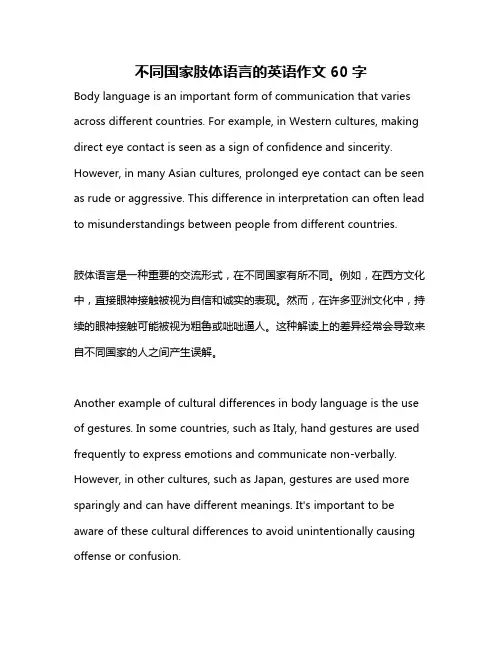
不同国家肢体语言的英语作文60字Body language is an important form of communication that varies across different countries. For example, in Western cultures, making direct eye contact is seen as a sign of confidence and sincerity. However, in many Asian cultures, prolonged eye contact can be seen as rude or aggressive. This difference in interpretation can often lead to misunderstandings between people from different countries.肢体语言是一种重要的交流形式,在不同国家有所不同。
例如,在西方文化中,直接眼神接触被视为自信和诚实的表现。
然而,在许多亚洲文化中,持续的眼神接触可能被视为粗鲁或咄咄逼人。
这种解读上的差异经常会导致来自不同国家的人之间产生误解。
Another example of cultural differences in body language is the use of gestures. In some countries, such as Italy, hand gestures are used frequently to express emotions and communicate non-verbally. However, in other cultures, such as Japan, gestures are used more sparingly and can have different meanings. It's important to be aware of these cultural differences to avoid unintentionally causing offense or confusion.肢体语言中文化差异的另一个例子是手势的使用。

趣谈中国与英美国家的肢体语言摘要:本文从三个方面分析了中国与英美国家的肢体语言的不同,从而得出不同国家的肢体语言受各国历史渊源的影响,有不同的表现。
关键词:中国;英美;肢体语言中国与英美国家的肢体语言种类繁多,贯穿于这其中的肢体语言有的可能表达方式相似但意义却大相径庭;有的也许具体动作不一样,可是想要表达的意思却终归是那么一种;更有这个国家与地域独有、换做在另一个地方完全不被理解消化甚至觉得是异类、不礼貌、犯了忌讳的肢体语言。
1 中国与英美国家相通的肢体语言1.1 表达方式相似但意义却大相径庭早在查尔斯·达尔文开始研究肢体语言之前,1872年他就曾写过一篇题为《人和动物情感表达》的文章。
他认为能读懂肢体语言无论对学习和工作都很有用。
生活中我们常见一些人因为一些事不停的使劲跺脚,如果说按照中国人的理解,会认为那对某事表示遗憾、感到泄气。
这些情境,相信我们在不同的场合也见过很多次了。
比如:当一名足球选手在高速运球、传球,不断突破对方选手的层层阻碍,准备将足球送入对方的大门时,由于失误,或由于各种非竞赛因素而没有将球最终攻破,我们就会看到那名选手有些气急败坏的跺着草坪。
那种显而易见的扼腕与失望通过他不断跺踏草坪的肢体动作显得更加让人叹息。
那么,跺脚这一蕴含丰富的肢体语言动作在西方国家尤其是美国又意味着什么呢?答案很简单,即没了耐性。
美国人思维方式比较单一直接,假如某天你恰好看到一位美国朋友在那儿跺脚,嘿,给个忠告,最好离他远点儿,没准儿您那位朋友已经处于暴躁中,完全没了所有耐性。
关于“鼓掌文化”。
中国和英语国家的鼓掌方式,固然都差不多,无非是两个手掌对拍,以发出声响。
可这其中的涵义就不能太插科打诨了。
举个简单的例子,一场成功而意义影响深远的话剧结束后,全体演员一同谢幕,台下观众起立欢呼,如果这一情境发生在中国,全场的掌声不只来自于观众,也有场上演员的。
观众们给予演员掌声,无可厚非,意思也很明显。
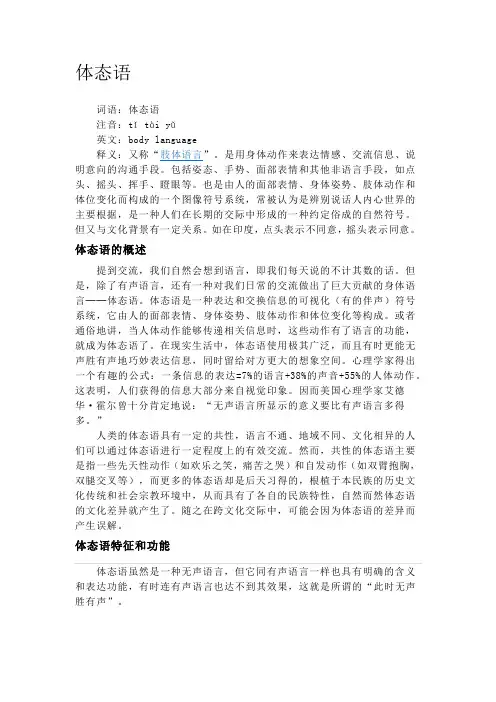
体态语词语:体态语注音:tǐ tài yǔ英文:body language释义:又称“肢体语言”。
是用身体动作来表达情感、交流信息、说明意向的沟通手段。
包括姿态、手势、面部表情和其他非语言手段,如点头、摇头、挥手、瞪眼等。
也是由人的面部表情、身体姿势、肢体动作和体位变化而构成的一个图像符号系统,常被认为是辨别说话人内心世界的主要根据,是一种人们在长期的交际中形成的一种约定俗成的自然符号。
但又与文化背景有一定关系。
如在印度,点头表示不同意,摇头表示同意。
体态语的概述提到交流,我们自然会想到语言,即我们每天说的不计其数的话。
但是,除了有声语言,还有一种对我们日常的交流做出了巨大贡献的身体语言──体态语。
体态语是一种表达和交换信息的可视化(有的伴声)符号系统,它由人的面部表情、身体姿势、肢体动作和体位变化等构成。
或者通俗地讲,当人体动作能够传递相关信息时,这些动作有了语言的功能,就成为体态语了。
在现实生活中,体态语使用极其广泛,而且有时更能无声胜有声地巧妙表达信息,同时留给对方更大的想象空间。
心理学家得出一个有趣的公式:一条信息的表达=7%的语言+38%的声音+55%的人体动作。
这表明,人们获得的信息大部分来自视觉印象。
因而美国心理学家艾德华·霍尔曾十分肯定地说:“无声语言所显示的意义要比有声语言多得多。
”人类的体态语具有一定的共性,语言不通、地域不同、文化相异的人们可以通过体态语进行一定程度上的有效交流。
然而,共性的体态语主要是指一些先天性动作(如欢乐之笑,痛苦之哭)和自发动作(如双臂抱胸,双腿交叉等),而更多的体态语却是后天习得的,根植于本民族的历史文化传统和社会宗教环境中,从而具有了各自的民族特性,自然而然体态语的文化差异就产生了。
随之在跨文化交际中,可能会因为体态语的差异而产生误解。
体态语特征和功能体态语虽然是一种无声语言,但它同有声语言一样也具有明确的含义和表达功能,有时连有声语言也达不到其效果,这就是所谓的“此时无声胜有声”。
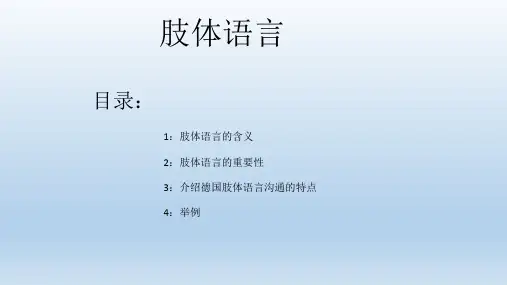
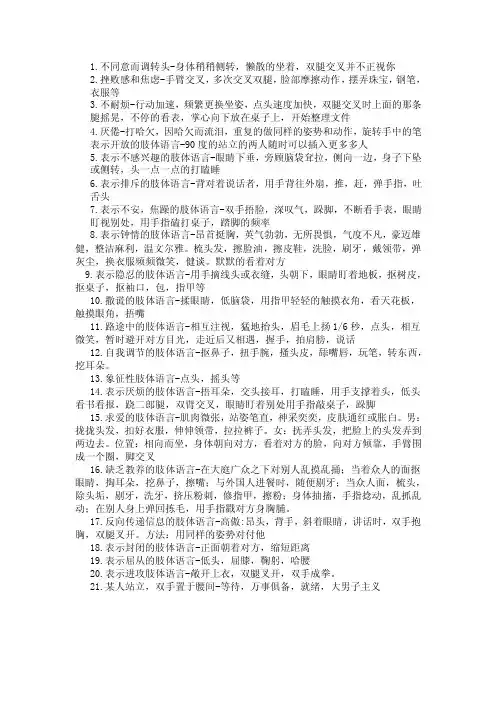
1.不同意而调转头-身体稍稍侧转,懒散的坐着,双腿交叉并不正视你2.挫败感和焦虑-手臂交叉,多次交叉双腿,脸部摩擦动作,摆弄珠宝,钢笔,衣服等3.不耐烦-行动加速,频繁更换坐姿,点头速度加快,双腿交叉时上面的那条腿摇晃,不停的看表,掌心向下放在桌子上,开始整理文件4.厌倦-打哈欠,因哈欠而流泪,重复的做同样的姿势和动作,旋转手中的笔表示开放的肢体语言-90度的站立的两人随时可以插入更多多人5.表示不感兴趣的肢体语言-眼睛下垂,旁顾脑袋耷拉,侧向一边,身子下坠或侧转,头一点一点的打瞌睡6.表示排斥的肢体语言-背对着说话者,用手背往外扇,推,赶,弹手指,吐舌头7.表示不安,焦躁的肢体语言-双手捂脸,深叹气,跺脚,不断看手表,眼睛盯视别处,用手指磕打桌子,踏脚的频率8.表示钟情的肢体语言-昂首挺胸,英气勃勃,无所畏惧,气度不凡,豪迈雄健,整洁麻利,温文尔雅。
梳头发,擦脸油,擦皮鞋,洗脸,刷牙,戴领带,弹灰尘,换衣服频频微笑,健谈。
默默的看着对方9.表示隐忍的肢体语言-用手摘线头或衣缝,头朝下,眼睛盯着地板,抠树皮,抠桌子,抠袖口,包,指甲等10.撒谎的肢体语言-揉眼睛,低脑袋,用指甲轻轻的触摸衣角,看天花板,触摸眼角,捂嘴11.路途中的肢体语言-相互注视,猛地抬头,眉毛上扬1/6秒,点头,相互微笑,暂时避开对方目光,走近后又相遇,握手,拍肩膀,说话12.自我调节的肢体语言-抠鼻子,扭手腕,搔头皮,舔嘴唇,玩笔,转东西,挖耳朵。
13.象征性肢体语言-点头,摇头等14.表示厌烦的肢体语言-捂耳朵,交头接耳,打瞌睡,用手支撑着头,低头看书看报,跷二郎腿,双臂交叉,眼睛盯着别处用手指敲桌子,跺脚15.求爱的肢体语言-肌肉微张,站姿笔直,神采奕奕,皮肤通红或胀白。
男:拢拢头发,扣好衣服,伸伸领带,拉拉裤子。
女:抚弄头发,把脸上的头发弄到两边去。
位置:相向而坐,身体朝向对方,看着对方的脸,向对方倾靠,手臂围成一个圈,脚交叉16.缺乏教养的肢体语言-在大庭广众之下对别人乱摸乱捅;当着众人的面抠眼睛,掏耳朵,挖鼻子,擦嘴;与外国人进餐时,随便剔牙;当众人面,梳头,除头垢,剔牙,洗牙,挤压粉刺,修指甲,擦粉;身体抽搐,手指捻动,乱抓乱动;在别人身上弹回拣毛,用手指戳对方身胸脯。

英语作文肢体语言在不同国家的含义English: Body language can vary greatly in meaning across different countries. For example, in Western cultures such as the United States, maintaining eye contact during a conversation is seen as a sign of attentiveness and honesty. However, in many Asian cultures, prolonged eye contact can be seen as disrespectful or confrontational. Similarly, gestures such as pointing with one's index finger may be considered impolite in some countries, while in others it may be a common way to give directions. Handshakes also vary in significance, with a firm handshake being the norm in many Western countries, but in places like Japan, a softer handshake is preferred. Understanding these cultural differences in body language is important for effective communication and avoiding misunderstandings in cross-cultural interactions.Translated content: 肢体语言在不同国家中的含义可能有很大的差异。
肢体语言中中西方文化差异探讨论文肢体语言中中西方文化差异探讨论文预读: 摘要:肢体语言是指能够传递某种信息的一种交流手段.美国心理学家阿尔伯特.马洛比恩发明了一个原则:总交流=7%的文字交流+38%口头交流+55%的面部表情交流.这一公式充分了说明了肢体语言在人类交流中的重要性.本文中所提到的肢体语言具体包括面部表情、手势或者其他身体部位的动作.这种肢体语言虽然曾经是人们沟通的一种初级手段,但是随着人类社会的不断进步,不同的地区和国家开始拥有自己的文化和历史.在这样的差异性中开始产生了不同的肢体语言.同时也会出现同一种肢体语言在不同的文化背景中所代表的含义也会各有不同.这就是我们跨文化交际中强调的中西方文化的差异和他们的思维模式的差异影响着人们相互之间的理解与交流.因此在用外语沟通时,就必须要求第二语言习得者在掌握语言的同时也要掌握不同文化中的肢体语言所表示的含义,这样才能使得沟通更加顺畅、成功.一、表情语的文化差异表情语是指通过眼、嘴、面部肌肉等变化表现出的脸部的情感体验.通常指的是面部表情和眼部动作.面部表情是形体动作语言中最能表现人情绪的非言语行为.当今时下比较流行的一词“微表情”说的就是通过面部表情来看出一个人的心理活动.因此我们说面部表情是最能体现人情绪的一种依据.人的喜、怒、哀、乐都可以通过各种信号和行为在脸上表露出来.但是在不同文化背景下,这种表情的表达也会存在一定的差异.比如说笑这个肢体语言,在中国和美国当你对一个陌生人投以微笑意味着表示对于对方的欢迎,对方也会向我们投以微笑以示友好.但是如果对方的回应是板着脸,我们也会立刻停止微笑.但是印第安人则是用哭来表示对对方的欢迎.另一个具有代表性的肢体语言动作就是吐舌头.在中国如果一个人感到自己的行为不和适宜或者非常尴尬的时候,经常会吐舌头,同时缩一下脖子.这个动作在多数中国女孩中较为常见,并有时候被其他人视为可爱.但是在美国人看来,吐舌头这个动作是非常粗鲁的,并且他们从来不去做.所以当与美国人接触时最好不要做这个动作,以免造成负面影响.表情语的另一个重要表现手段是目光接触.目光语在肢体语言中也扮演着非常重要的角色.就像俗语说:眼睛是心理的窗户.透过一个人的眼睛的表情我们可以观看到他的内心世界.例如,来自英语国家的人在谈话中会使用更多的目光交流,美国人讲话就会非常注意目光接触的时间和方式.在普通对话中,他们会对看一分钟然后再挪开.如果两个美国人互相凝视,那就表明他们之间的关系很亲密.在北美,孩子们必须学会直视对方的眼睛,否则就会被认为缺乏激情和自信.二、身势语的文化差异身势语是指人们借助手、脚、身体来表达自己的思想.在人与人的沟通中,人们除了用语言来表达信息以外,还可以通过身体的动作来表达意思.可以说身势语的信息传递同言语信息传递一样,也是信息发出者编码到信息接收者解码的过程.因此想要用外语进行有效沟通就必须对不同文化的身势语有所了解.身势语的第一表现形式即是最普遍的表现形式为手势语,就是我们经常接触到的“打手势”.不同的手部动作有着不同的行为代码和文化含义.以握手为例,在沙特熟人之间在谈话的过程中也会通过握手来表示彼此的尊重的意思.但是如果你在澳大利亚或者是英格兰面对熟人千万不要以这种方式来问候,因为在这些国家里握手的动作通常发生在两人之初以及分手道别之时.同一种身势语的交际功能也会随着文化的改变而变化.如有些文化中如中国,认为点头就是表示支持肯定的意思,摇头来表示否定的意思但在印度等地人们却用摆头来表示对对方的肯定,而相反点头则是表示对于对方的否定.英美人常常做出吧拇指指尖和食指指尖对接构成圆形,其余三指自然伸出的手势,这个手势在这些国家表示的是“OK”或者非常好,但是在法国南部地区表示的意思则是零或者一文不值,在很多拉丁美洲国家则被视为是一种不敬的行为.三、小结根据原创论文数据分析研究,本文认为,肢体语言是各国文化差异的生动的体现.在夸文化交际中,我们不仅要重视语言交际的的差异同时也要重视肢体语言的差异性,英语学习者应该了解并熟悉不同文化背景下各种肢体语言的确切含义,是自己能够在交流沟通中更为准确的掌握对方的意思,避免产生不必要的交际障碍.正如谚语中所说的“WheninRome,doastheRomansdo.”我们在跨文化交际的过程当中应当了解并且尊重对方与我们之间的文化差异,熟知其风俗文化、信仰和他们的肢体语言,这样才能提高沟通的实效性.。
中西方文化差异及语言体现5篇肢体语言的中西方文化差异尼泊尔人、斯里兰卡人和有些印地安人和爱斯基摩人用点头表示“不”。
因此,要用外语进行有效的交际,在说某种语言时就得了解说话人的手势、动作、举止等所表示的意思。
我们可以观察一下阿拉伯人同英国人谈话。
阿拉伯人按照自己的民族习惯认为站得近些表示友好。
英国人按照英国的习惯会往后退,因为他认为保持适当的距离才合适。
阿拉伯人往前挪,英国人往后退。
谈话结束时,两个人离原来站的地方可能相当远!在这个例子里,双方的距离是关键。
不同的民族在谈话时,对双方保持多大距离才合适有不同的看法。
根据研究,据说在美国进行社交或公务谈话时,有四种距离表示四种不同情况:关系亲密,私人交往,一般社交,公共场合。
交谈双方关系亲密,那么身体的距离从直接接触到相距约45厘米之间,这种距离适于双方关系最为亲密的场合,比如说夫妻关系。
朋友、熟人或亲戚之间个人交谈一般以相距45~80米为宜。
在进行一股社交活动时,交谈双方相距1.30米至3米;在工作或办事时,在大型社交聚会上,交谈者一般保持1.30米至 2米的距离。
在公共场合,交谈者之间相距更远,如在公共场所演说,教师在堂上讲课,他们同听众距离很远。
多数讲英语的人不喜欢人们离得太近,当然,离得太远也有些别扭。
离得太近会使人感到不舒服,除非另有原因,如表示喜爱或鼓励对方与自己亲近等,但这是另一回事。
记住这一点很重要。
在英语国家里,一般的朋友和熟人之间交谈时,避免身体任何部位与对方接触。
即使仅仅触摸一下也可能引起不良的反应。
如果一方无意触摸对方一下,他(她)一般会说 Sorry;Oh,I’m sorry; E_cuse me等表示“对不起”的道歉话。
在中国,常常听到西方妇女抱怨中国人抚弄了她们的婴儿和很小的孩子。
不论是摸摸、拍拍、接接或是亲亲孩子,都使那些西方的母亲感到别扭。
她们知道这种动作毫无恶意,只是表示亲近和爱抚而已,所以也不好公开表示不满。
但在她们自己的文化中,这种动作会被人认为是无礼的,也会引起对方强烈的反感和厌恶。
在中国和另一个国家,是否有不同的手势和肢体语言?中国和另一个国家肢体语言与手势的差异手势和肢体语言是人类交流的重要方式之一。
虽然共同的生命经验和文化背景能够帮助我们理解彼此的肢体语言,但是在不同的文化背景中,在交际中可能会出现一些困难,让人们互相误解。
在本篇文章中,我们将讨论在中国和其他国家的肢体语言和手势方面的差异,并为大家提供一些有用的参考信息。
一、中国的肢体语言和手势中国是一个礼仪文化非常重要的国家,因此在交际中肢体语言和手势也非常注重。
以下是中国文化中经常使用的肢体语言和手势:1. 手心向下:在中国,如果你用手的手心向下示意某人,表示你希望他或她保持安静。
2. 合掌:合掌是中国人用来表示敬礼和感激的姿势。
3. 拜拜:拜拜是中国人常用的告别姿势。
4. 黑人问号:当中国人不理解某些意思的时候,他们会用额头皱起来的表情以及手指着嘴巴的姿势,类似于黑人问号的模样。
5. 吸气:中国人很喜欢用吸气的姿势来表示惊讶或者惊奇。
二、与中国相邻国家的肢体语言和手势1. 日本:和中国一样,合掌也是日本人常用的肢体语言。
此外,和中国人相比,日本人更注重肢体姿势和面部表情的细微变化。
例如,在交际中,他们会有意识地控制自己的眼神,以避免直接注视对方的眼睛。
2. 印度:印度人民非常重视肢体语言和面部表情。
他们常常使用印度式敬礼手势来表示敬意,双手合十的敬礼方式在印度发扬光大。
3. 朝鲜:和中国一样,朝鲜人也要求对方保持适当的距离,如果过近会感到不舒适。
一些简单而常见的肢体语言包括弯曲的头部、轻轻点头、以及手放在心口。
三、如何避免肢体语言和手势的误解在不同文化间交际时,肢体语言和手势的误解非常常见。
在这里,我们将列出一些有用的建议:1. 学习对方文化的基本礼仪:了解对方文化的基本礼仪可以帮助你避免肢体语言和手势误解。
2. 尊重对方:无论他们使用什么肢体语言或手势,尊重对方并避免冒犯对方是非常重要的。
3. 温和和亲切:温和地使用肢体语言和手势并不是错的,而是可以帮助两个文化之间的人建立良好的交际关系。
英语作文肢体语言在不同国家的含义全文共6篇示例,供读者参考篇1The Meaning of Body Language in Different CountriesHave you ever been confused about what someone's body movements meant? Body language is how people communicate without using words. It includes things like gestures, facial expressions, eye contact, and posture. While some body language is universal, a lot of it actually means different things in different countries and cultures around the world!Let's start with hand gestures. In the United States and United Kingdom, giving a "thumbs up" generally means you approve of something or you're saying "good job." But in some other places, like parts of the Middle East, it's considered rude and offensive! In those regions, the "thumbs up" can mean something very disrespectful.Another example is the "okay" hand sign, where you make a circle with your thumb and index finger. In English-speaking countries, this hand sign means "okay" or "everything is good." But in countries like Brazil, Germany, and Russia, it's a very rudegesture that people would not appreciate! In France, this same "okay" sign actually means "worthless" or "zero."Pointing is another type of body language that varies. In the United States and Canada, it's normal to point with your index finger to indicate a direction or person. But in some Asian cultures like Malaysia and Indonesia, pointing with your index finger is impolite. Instead, they point with an open hand or their thumb.Eye contact is important too. In Western cultures, consistent eye contact shows you are paying attention and engaged. But in many Asian, Hispanic, and Indigenous American cultures, too much direct eye contact can be seen as disrespectful or aggressive, especially toward elders.Certain hand gestures can also mean totally different things in various countries. In Greece and Cyprus, nodding your head up and down means "no," while shaking it left and right means "yes"-- the opposite of what it means in places like the U.S.! And in Italy, the hand gesture where you make a circle with your fingers means "everything is perfect," but in France, that same gesture actually means "worthless."Even a simple thumbs down has varying meanings across cultures. While it often communicates negativity, it's an offensivehand signal in places like West Africa and parts of the Middle East. But in ancient Rome, it was used by leaders to decide whether to spare or execute convicted criminals!One gesture that is fairly universal is the wave hello using an open palm. Whether it's one hand or both hands, the wave is a friendly greeting in most cultures around the globe.Sometimes, differences in body language meanings are not about hand gestures, but about personal space. In North America and Europe, people tend to prefer more personal space, standing 3-4 feet apart. But in many Central American, South American, Mediterranean, and Arab countries, people stand much closer together in normal conversation.The same posture or movement can have completely different meanings in various parts of the world. When you travel, it's important to learn about local body language so you can communicate properly and avoid accidentally offending or confusing people. Body language is a fascinating part of communication and culture!篇2The Meaning of Body Language in Different CountriesWhenever people talk to each other, they don't just use their words. They also move their bodies in little ways, like smiling, frowning, nodding their heads, or putting their hands on their hips. These little movements are called "body language." Body language can mean different things in different countries around the world. Isn't that neat?In the United States, some common body language includes a thumbs up, which means "good job" or "I like that." When Americans want someone to come over, they might wave their hand palm-down. Nodding your head up and down means "yes," while shaking it side to side means "no." People put their hands on their hips when they feel sassy or proud.Kids in France actually use a different hand gesture to say "so-so" or "kind of." They make a funny face and wobble their hand back and forth with the palm facing down. In Italy, people make a circle with their thumb and index finger to say "Okay" or "Perfect." I tried doing that at home once, and my dad thought I was calling him a bad word! Oops!In Japan, people bow a lot as a sign of respect. The deeper you bow, the more respect you're showing. Students bow to their teachers, and children even bow to their parents sometimes.I tried bowing really low to my mom once, but she just laughed at me. In America, we don't really bow to each other.Some body language looks the same in different countries, but can mean totally different things! Like in Bulgaria, if you nod your head up and down, it means "no." But if you shake it side to side, that means "yes!" That's the total opposite of what it means in America. How confusing is that?One tricky body language is the "OK" sign where you make a circle with your thumb and index finger. In America, that means everything is okay or alright. But in Brazil, that's considered a really rude gesture! In Turkey, it's even worse - people might think you're calling them a very bad name. No thank you!Isn't it wild how one tiny hand movement can mean such different things in various places? Waving goodbye is normal for Americans, but in Bangladesh, that's how people call others over to them. And get this - putting your thumb on your nose and wiggling your fingers is just a goofy thing kids do in the USA. But in Russia, it's a super disrespectful way to tease someone! Who knew?Body language reminds me that even though people all over the world might look basically the same on the outside, we can have very different ways of communicating without words. Thenext time I'm traveling, I'll have to be very careful about which hand gestures I use so I don't accidentally insult someone. Or maybe I'll just try sticking to using my words! Either way, isn't studying different cultures fascinating? I sure think so!篇3The Meanings of Body Language in Different CountriesHey there! My name is Emma and I'm going to tell you all about how body language can mean different things in different countries. It's really interesting and important to know about so you don't accidentally offend someone or get confused. Let me give you some examples!In the United States and Canada, giving a thumbs up means "good job" or "I like that." But in some other places like Iran, Thailand, and Greece, the thumbs up is actually an insulting gesture! In those countries, you shouldn't do it because people will think you're being rude. Wild, right?Another hand signal that means something positive in the U.S. is the "OK" sign, where you make a circle with your thumb and index finger. Here it just means "okay" or "alright." But in France, Belgium, and Tunisia, that same hand sign actually means"worthless" or "zero"! You could really mix up the meaning if you're not careful.Speaking of hand signs, here's a funny one. In the United States, we stick our tongue out at people when we're teasing them or insulting them in a playful way. But in China and India, sticking your tongue out at someone is considered a seriously offensive insult! You definitely don't want to do that by accident.Now let's talk about some differences with head movements. In the U.S., nodding your head up and down means "yes" and shaking it side to side means "no." Easy enough! But in Bulgaria, they actually do the opposite - nodding up and down means "no" and shaking the head side to side means "yes." How confusing is that?I visited my cousin in India last year and learned that the big head wobble they do can mean anything from "yes" to "no" to "maybe" to "I understand" depending on the context. We definitely don't do that in America!Eye contact is another interesting one. In American and Canadian culture, it's considered polite and respectful to make eye contact when speaking to someone. But in many Asian and Native American cultures, avoiding eye contact is actually a signof respect, especially with elders. Breaking eye contact shows you aren't trying to challenge the other person.How about pointing? In America and Europe, we point with our index finger a lot to indicate directions or draw attention to things. But in some Asian countries like Indonesia and Malaysia, pointing with your index finger is considered very rude. If you need to point or gesture, it's better to use your whole hand instead of just one finger.Let's not forget about personal space! Americans and Europeans tend to stand a few feet apart when talking to keep a comfortable distance. But in countries like Saudi Arabia and Italy, people stand much closer together, almost chest-to-chest. It can feel like your personal space is being invaded if you're not used to it.And finally, one of the most common differences is how people greet each other. While Americans usually just wave, shake hands, or give a quick hug, many other cultures have much more elaborate greeting rituals and customs. In the Pacific Islands, people will bump noses and foreheads as a greeting. In Tibet, they stick their tongues out at people they really like or respect! And in Oman, men greet each other with a nose rub and forehead touch. So unique!Isn't it wild how body language can mean totally different things across cultures? You really have to be aware of the local customs to avoid awkward situations. Pay close attention when you travel and always be respectful. Body language is like a secret code - and we've gotta crack that code!Well, that's all I've got for you today. Learning about body language around the world has been so eye-opening for me. I hope you found it interesting too! Maybe next time you're on vacation you can try out some new gestures and greet people like a local. Just be careful with those hand signs...you don't want to accidentally insult the prime minister or anything! Thanks for reading, gotta run!篇4The Meaning of Body Language in Different CountriesDid you know that people in different countries use their bodies to communicate in very different ways? Body language is like a secret code that everybody learns without even trying! The way you move your hands, nod your head, or stand can actually mean something totally different depending on where you are in the world. Isn't that wild? Let me tell you about some of the coolest body language meanings I've learned about.In the United States, we use a lot of hand motions when we talk. If we want someone to come over, we might wave our hand palm-down while curling our fingers inwards. Or if something is really good, we give a big thumbs up! The thumbs up means "Great job!" or "Way to go!" in America. But be careful - in some countries like Iran, Afghanistan, and parts of Italy, the thumbs up is actually really rude! It's kind of like giving the middle finger. Oops! In those places, you're better off doing a thumbs up with the thumb joined to the index finger in a circle. That means "Okay" or "Perfect."Speaking of rude hand gestures, in America if you stick out your middle finger at someone, that's super impolite. Don't do it! But in places like Sardinia or Nigeria, the middle finger doesn't mean much at all. You could stick it out and nobody would be upset. Crazy, right? In Nigeria though, you'd better be careful about making the okay sign with your thumb and index finger. Over there, that's the rude hand signal!Head movements can get confusing between countries too. In the US, India, and lots of other places, nodding your head up and down means "Yes." But in Bulgaria, that same nodding motion actually means "No"! They shake their heads from side to side for "Yes." I'd get so mixed up if I visited Bulgaria!Some of the funniest body language mixes-ups involve insulting people by accident. Like in Greece, giving the sign for "Okay" by making a circle with your thumb and index finger is super disrespectful because it looks like an insult about someone's...well, you know. Same thing in France and Turkey - that "Okay" gesture is basically calling someone rude names. No thanks!In Brazil, clicking your tongue and sucking air through your teeth is just something you might do when you're thinking. But in some Middle Eastern countries, that noise is how you'd call a dog over! You wouldn't want to accidentally do that to somebody. Yikes!Pointing is another tricky body language. In the US and Canada it's no big deal to point at things with your finger. But in Singapore, that's considered aggressive and disrespectful. Same in many Asian and African cultures - you're better off pointing with your whole hand instead of just one finger.Some places have such unique body language too. Like in Italy, they make these funny hand shapes to express different feelings. Flicking the fingers on one hand outwards means "What do you want?" And holding your hand up with the fingers looselycurled means "I don't care." Those Italians have a whole language just in their hands!My favorite weird body language fact is about snapping fingers. In the United States and Europe, snapping your fingers is just a way to get someone's attention or keep a beat with music. But in Ghana and Nigeria, snapping at someone is majorly disrespectful, kind of like giving them the middle finger! People will think you're being so rude if you snap your fingers over there.Isn't it incredible how much body language can change just by crossing a few borders? People in different countries end up giving totally different meanings to the same gestures and movements without even realizing it. To me, that's one of the coolest things about how many diverse cultures we have on our planet.Learning about body language from around the world makes me want to be a more careful communicator. I'll have to remember - no thumbs up in Iran, no tongue clicks in Saudi Arabia, and definitely no snapping my fingers if I ever visit West Africa! Using body language correctly shows respect for the places you visit and the people you meet. Our bodies might be small, but the ways we move them have big, big meanings.篇5The Meaning of Body Language in Different CountriesDid you know that the way you move your body can mean different things depending on where you are in the world? It's true! The same gesture that means one thing in your country might mean something totally different in another place. Body language is like a secret code that people use without even realizing it. Let me tell you about some of the funny and interesting body language meanings from around the globe!In the United States and many other Western countries, nodding your head up and down means "yes" and shaking it from side to side means "no." But in Bulgaria, they do the opposite! Shaking your head back and forth means "yes" and nodding up and down means "no." Can you imagine how confusing that would be if you didn't know the difference?Speaking of head movements, did you know that in India, they use a special head bobble to show that they're listening and understanding what you're saying? It's like a tiny nodding motion. If you just saw it without knowing what it meant, you might think the person was saying "no" over and over again!Let's talk about hand gestures for a minute. In many places, waving your hand with your palm facing out is how you say "hello" or "bye." But in Greece, that same hand wave means "no" or "go away!" Yikes, you wouldn't want to accidentally insult someone by using the wrong hand signal.Here's a really funny one - in Brazil, making the "okay" sign by making a circle with your thumb and forefinger is considered rude and offensive. But in the United States, that hand signal just means everything is alright or okay. You can see how using the wrong body language could get you into trouble if you're not careful!Sometimes, even the way you smile can have different meanings. In Russia, smiling at strangers is considered weird and impolite. But in the United States, people usually smile at each other when passing on the street as a friendly gesture. A Russian person might think someone from the US is being strange for smiling at them randomly.One more example of how body language differs is pointing with your fingers. In many Western countries, it's normal and polite to point with your index finger when giving directions. But in some Asian countries like Malaysia or Indonesia, pointing withthe entire hand is considered more respectful than just using one finger.Isn't it incredible how something as simple as a nod, a hand wave, or a smile can be interpreted in totally different ways depending on what country you're in? Body language is like a secret language that everyone uses without even thinking about it. The same exact motions that seem totally normal in one culture might seem rude, silly, or confusing in another place.So next time you're traveling to a new country or even just meeting someone from a different background, remember to be aware of body language. Pay close attention to the gestures people use and what they mean. That way, you can avoid any awkward misunderstandings and communicate clearly with the people around you, no matter where you are in the world!篇6The Meanings of Body Language in Different CountriesHave you ever waved at someone and they looked confused? Or maybe you put your thumb up to say "good job" and the other person seemed upset? That's because body language - the gestures and movements we make - can mean very different things in different countries around the world!In the United States and many other Western nations, nodding your head up and down means "yes" and shaking it side to side means "no." But in Bulgaria, shaking your head side to side actually means "yes"! And in India, nodding sideways or tilting your head is how people show they understand.Here's another confusing one - in most of Europe, America, and Australia, we stick our thumb up to say "well done" or "good job." But that same "thumbs up" gesture is actually very rude in countries like Iran, Nigeria, and Thailand! In those places, people think it means you're calling them a butthead or making fun of them.Let's talk about hand gestures. In Italy, Greece, Spain, and Turkey, people use their hands a lot when talking. But some of those gestures don't mean the same things as they do here. Like if you make a circles with your thumb and index finger in Italy, it's saying "everything is great!" or "perfect!" But in France, that same circle means "worthless." Oops!Speaking of hands, we use our fingers to count from 1 to 5 here. But in China, Germany, and Russia, people start counting with the thumb first, then the index finger for 2, and so on. And in places like Japan and Taiwan, they actually start counting from 1 with the index finger, not the thumb!Waving hello is normal for us, but did you know in Norway, waving is only for saying goodbye? If you wave at a Norwegian when you first see them, they might get confused! And in the Buddhist tradition, monks greet each other by putting their hands flat together in a prayer gesture. That's their way of saying hello respectfully.Eye contact is another interesting one. Here in the US, we're taught to make eye contact when someone is speaking to you to show you're paying attention. But in many Asian cultures like China, Japan, and Korea, avoiding someone's direct gaze is actually a sign of respect, especially with elders or authority figures.What about crossing your legs while seated? That's no big deal here, but in cultures like Turkey and Saudi Arabia, it's considered very impolite and disrespectful. The same goes for pointing the bottoms of your feet or shoes at someone - a major no-no in many Asian and Middle Eastern nations.The meaning of personal space and touching can be different too. Southern Europeans and Latin Americans tend to stand much closer during conversation than we do. And while a pat on the back or brief hug is normal here, that kind of casual touch would make many East Asians uncomfortable.As you can see, the way we communicate without words can be easily misunderstood in other parts of the world! When traveling, it's a good idea to learn the local body language so you don't accidentally offend someone. Or you could just stick to some simple, polite gestures like a small bow, a wave, or a friendly smile. Those tend to translate pretty well anywhere you go!So next time someone gives you a strange look for how you're standing or what hand sign you made, just remember - body language isn't quite the same universal language we thought! It takes some cultural awareness to truly understand the secret codes of gestures used around the globe.。
浅析中美文化中肢体语言的差异随着全球经济的发展和国际交流,世界已经成为一个地球村。
人们随时都会面对来自其他文化的朋友。
在人们的交流沟通过程中,文字语言并不是表达我们的想法和感受唯一的方式,肢体语言同样重要,两者相辅相成才能达到交流的预期效果。
然而,不同的文化造就了不同肢体沟通方式,不同的人也用不同的手势传达自己的表情。
中国和美国作为世界大国,在世界政治和经济舞台上扮演着重要角色,两国之间的交往频率一直处于上升中,学习肢体语言的不同与共同规则,将会有助于中美国两国之间进行更好的沟通与合作,有利于世界的和平与国际经济的健康发展。
1 中美肢体语言的差异1.1 距离来自不同文化背景的人在两个人交流时距离的问题上有着不同的看法。
它不仅显示了两个人之间的交际关系和心理状态,但也反映出民族文化特点。
中国人和美国人在该问题上的观点存在明显的差异。
有时你感觉对的行为,可能完全冒犯了对方的文化。
在研究过程中笔者发现,相比于中国人,美国人会保持更大的互动距离。
通过反复观察和细致的对比研究和阅读文献,正如所说,在美国社会与商业关系中有四种距离亲密、私人、社会和公众。
对于亲密的距离(045cm),一般出现在人们最私人的关系和活动中,如亲戚、亲密的朋友、情人和夫妻。
私人距离保持在45120cm,是最常见的普通朋友和熟人。
他们互相认识,但没有特殊关系。
xxxx。
一起工作或做生意的人,xxxx。
公共距离是3.60m。
该区域被预留给公众演讲,或者一般来说,当一大群人一起聊天时。
最重要的是要记住的是,大多数美国人都不喜欢过于亲近。
过于远,当然也可能是尴尬的,但是走的太近会让人不舒服。
因此,应该保持合适的距离。
1.2 触摸与他人接触也是一种沟通的方式。
文化人类学已经将联系分为两类:联系文化和接触文化。
美国属于联系文化而中国属于后者。
当美国人排队时,他们总是刻意保持距离。
如果有人与他太近,第一反应是离开。
如果不是这样,他会倾斜到一边。
——文章来源网,仅供分享学习参考
~ 1 ~
关于身体,肢体语言
点头表示同意,摇头表示不同意。这些手势对说汉语和外国人都具有
相同涵义。
不同国家有不同的身体语言。例如,在俄罗斯,法国和阿拉伯国家里,
男人亲吻对方见面时,但在中国或澳大利亚男人不是亲吻而是握手。
在波多黎哥,人们喜欢相互接触,而英语国家的人不大这么做对方。
如果你碰了一下英国人,你应该说声“对不起。在阿拉伯国家的人们
喜欢彼此站得很近的时候,他们所谈论的,但英国人民必须保持距离,
当他们说话。在亚洲一些国家里,你不可以触摸别人的头。在阿拉伯
国家,吃饭用你的右手手指,左手是不是所有使用。在亚洲的某些地
方,你不能坐着把脚跷起对着别人。
当您使用一门外语,这是非常重要的是知道在外国的手势和动作的含
义。继海关将帮助你与人交流,让你在此很愉快,舒适。
点头和摇头阿拉伯地区、印度、阿尔巴尼亚等地方就是点头为NO,摇头为YES而在中国点头为YES,摇头NO。
在很多国家,点头是肯定,摇头是否定,但是在保加利亚,希腊的一些地方,和伊朗,却是点头否定,摇头肯定在用手势表示数字时,中国伸出食指表示“1”,欧美人则伸出大拇指表示“1”;中国人伸出食指和中指表示“2”,欧美人伸出大拇指和食指表示“2”,并依次伸出中指、无名指和小拇指表示“3”、“4”、“5”。
在中国伸出食指指节前屈表示“9”,日本人却用这个手势表示“偷窃”。
中国人表示“10”的手势是将右手握成拳头,在英美等国则表示“祝好运”。
手势“OK”在印度,表示“正确”;在泰国,表示“没问题”;在日本、缅甸、韩国,表示“金钱”;在法国,表示“微不足道”或“一钱不值”;在巴西、希腊和意大利的撒丁岛,表示这是一种令人厌恶的污秽手势;在马耳他,则是一句无声而恶毒的骂人语。
OK手势。
拇指、食指相接成环形,其余三指伸直,掌心向外。
OK手势源于美国,在美国表示“同意”、“顺利”、“很好”的意思;而法国表示“零”或“毫无价值”;在泰国它表示“没问题”,在巴西是表示粗俗下流。
中国人表示赞赏之意,常常翘直大拇指,其余四指蜷曲;跷起小拇指则表示蔑视。
日本人则用大拇指表示“老爷子”,用小拇指表示“情人”。
在英国,翘起大拇指是拦路要求搭车的意思。
在英美等国,以“V”字形手势表示“胜利”、“成功”;在亚非国家,“V”字形手势一般表示两件事或两个东西。
V形手势。
这种手势是二战时的英国首相丘吉尔首先使用的,现在已传遍世界,是表示“胜利”。
如果掌心向内,就变成骂人的手势了。
1.盯着别人的眼睛看,在一些国家是表示对对方感兴趣,但在另一些国家,是被认为无理的,对别人不尊重.3.美国的手势__竖起大拇指,在美国表示"很好""干得不错",但是在尼日利亚,这个手势很粗鲁但是在日本和德国,它意味着"第一".翘起大拇指,一般都表示顺利或夸奖别人。
但也有很多例外,在美国和欧洲部分地区,表示要搭车,在德国表示数字“1”,在日本表示“5”,在澳大利亚就表示骂人“他妈的”。
与别人谈话时将拇指翘起来反向指向第三者,即以拇指指腹的反面指向除交谈对象外的另一人,是对第三者的嘲讽。
掌心向下的招手动作,在中国主要是招呼别人过来,在美国是叫狗过来。
举手致意。
它也叫挥手致意。
用来向他人表示问候、致敬、感谢。
当你看见熟悉的人,又无暇分身的时候,就举手致意,可以立即消除对方的被冷落感。
要掌心向外,面对对方,指尖朝向上方。
千万不要忘记伸开手掌。
与人握手。
在见面之初、告别之际、慰问他人、表示感激、略表歉意等时候,往往会以手和他人相握。
一是要注意先后顺序。
握手时,双方伸出手来的标准的先后顺序应为“尊者在先”。
即地位高者先伸手,地位低者后伸手。
如果是服务人员通常不要主动伸手和服务对象相握。
和人握手时,一般握上3到5秒钟就行了。
通常,应该用右手和人相握。
左手不宜使用,双手相握也不必常用。
双手抱头。
很多人喜欢用单手或双手抱在脑后,这一体态的本意,也是放松。
在别人面前特别是给人服务的时候这么做的话,就给人一种目中无人的感觉。
摆弄手指。
反复摆弄自己的手指,要么活动关节,要么捻响,要么攥着拳头,或是手指动来动去,往往会给人一种无聊的感觉,让人难以接受。
手插口袋。
在工作中,通常不允许把一只手或双手插在口袋里的。
这种表现,会让人觉得你在工作上不尽力,忙里偷闲。
二是手势宜少不宜多。
手势宜少不宜多。
多余的手势,会给人留下装腔作势、缺乏涵养的感觉。
三是要避免出现的手势。
在交际活动时,有些手势会让人反感,严重影响形象。
比如当众搔头皮、掏耳朵、抠鼻子、咬指甲、手指在桌上乱写乱画等。
Pat on the HeadIn America, you may pat a younger person on the head or ruffle their hair to indicate encouragement or affection. However, in cultures where Buddhism and Hinduism are predominant, the gesture may be offensive. In Buddhist and Hindu faiths, the head is typically viewed as the spirit's place of residence.Pat on the BackYou may be accustomed to patting your teammates on the back after successfully completing a task. Other times, you may simply use the gesture to indicate neighborly affection. Other cultures may take this action as intrusive or aggressive.SmilingWhile smiling is a universally acknowledged gesture, a smile may convey different meanings. For example, in addition to openness, a smile can convey embarrassment or confusion. In some cultures, it is normal to reserve a smile for friends or family,rather than passing strangers.Thumbs-UpA thumbs-up gesture may send a positive message in America, but this is not the case worldwide. For example, in some Middle Eastern cultures, the gesture has the same implications as raising your middle finger in America. Similarly, the "ok" gesture, formed by bringing the tip of your index finger to the top of your thumb, can be interpreted as obscene in Brazil and Germany.Fingers in a "V"In America, holding your index and middle fingers out in the shape of a "V" is a sign of peace meant to imply friendliness; it could also be interpreted as a sign of victory. However, if you're overseas, be sure to present this sign with your palm facing outward. If your palm is inward, the gesture can serve as an insult in countries such as Australia, New Zealand and Ireland.Finger BeckoningBeckoning a person by curling your index finger is generally acceptable in America, although, depending on the context, it may be a rude form of summons. In some areas, such as the Philippines, you should only use this gesture when beckoning a dog.Although we may not realize it when we talk with others we make ourselves understood not only by words. We send messages to the people around us also by expressions and body movements.we call it "body language ",which is a kind of communication,noverbal communication.A smile and handshake show welcome ,Waving one's hand is to say"goodbye", nodding the head means agreement,while shaking it means disgreement .Putting up a hand means"May I ask a question?". Kissing means"love". Waving one's arms show happiness.These gestures are accepted both by Chinese and Americans as having the same meanings.Because culture influences communication.Different country has different culture.So the way people in different countries communicate is different too.FOR EXAMPLE, Arab man often greet by kissing on both cheeks.In Japan men greet by bowing .In the Unite States, people shake hands to show"their greeting". And the gesture of putting a hand on a person' neck is different for Chinese and Americans. For Chinese,it is to say"someone will be killed". For Americans, it shows"I'm full” .And in Thailand, If you want to signal a person to come near, you should move the fingers back and forth with palm down.But in theUnited States, you ask someone to come by holding the palm up and moving the fingers towards our body. And crossing one's legs in the United States is a sign of being relaxed. But in Korea , it's not allowed. In Chinese,people hand everything with both hands to show their respect,but for Muslims,they think the left hand is unclean and do not eat or pass something with it.Because of special culture influences some counties, some body languages should attract our attention. In Turkey , putting one's hand in one's pockets is a sign of disrespect,In some Asican countries, you must not touch the head of another person. And in China, people don't kiss or hug each other ,except hisher lover. For an Arab, it is a good manners to stand close to his friend when they are talking, but for English people, they don't like to be close to one another.And in parts of Asia, you must not sit with your foot pointing at another person.All above show that it is important to know the meaning of gestures and movements in foreign country, foreigners should follow these customs, should learn their culture. So we can communicate with them in a correct way, not only by words, but also by body language. I think that it is important in our lives to show and learn body language ..。